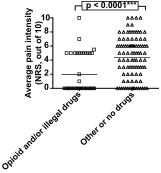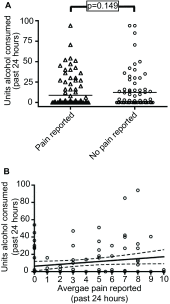The nature and prevalence of chronic pain in homeless persons: an observational study
- PMID: 24555079
- PMCID: PMC3886796
- DOI: 10.12688/f1000research.2-164.v1
The nature and prevalence of chronic pain in homeless persons: an observational study
Abstract
Background: Homeless people are known to suffer disproportionately with health problems that reduce physical functioning and quality of life, and shorten life expectancy. They suffer from a wide range of diseases that are known to be painful, but little information is available about the nature and prevalence of chronic pain in this vulnerable group. This study aimed to estimate the prevalence of chronic pain among homeless people, and to examine its location, effect on activities of daily living, and relationship with alcohol and drugs.
Methods: We conducted face-to-face interviews with users of homeless shelters in four major cities in the United Kingdom, in the winters of 2009-11. Participants completed the Brief Pain Inventory, Short Form McGill Pain questionnaire, Leeds Assessment of Neuropathic Symptoms and Signs, and detailed their intake of prescribed and unprescribed medications and alcohol. We also recorded each participant's reasons for homelessness, and whether they slept rough or in shelters.
Findings: Of 168 shelter users approached, 150 (89.3%) participated: 93 participants (63%) reported experiencing pain lasting longer than three months; the mean duration of pain experienced was 82.2 months. The lower limbs were most frequently affected. Opioids appeared to afford a degree of analgesia for some, but whilst many reported symptoms suggestive of neuropathic pain, very few were taking anti-neuropathic drugs.
Interpretation: The prevalence of chronic pain in the homeless appears to be substantially higher than the general population, is poorly controlled, and adversely affects general activity, walking and sleeping. It is hard to discern whether chronic pain is a cause or effect of homelessness, or both. Pain is a symptom, but in this challenging group it might not always be possible to treat the underlying cause. Exploring the diagnosis and treatment of neuropathic pain may offer a means of improving the quality of these vulnerable people's lives.
Conflict of interest statement
Figures



References
-
- Wright JD: Poor people, poor health: the health status of the homeless. J Soc Issues. 1990;46(4):49–64 10.1111/j.1540-4560.1990.tb01798.x - DOI
-
- 2008. Crisis: Homelessness policy watch: homelessness kills.Reference Source
LinkOut - more resources
Full Text Sources
Other Literature Sources

